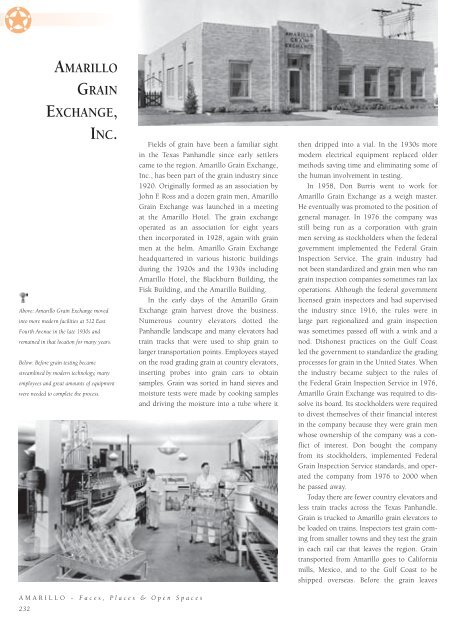amarillo chamber of commerce - HPN Books
amarillo chamber of commerce - HPN Books
amarillo chamber of commerce - HPN Books
You also want an ePaper? Increase the reach of your titles
YUMPU automatically turns print PDFs into web optimized ePapers that Google loves.
AMARILLOGRAINEXCHANGE,INC.Above: Amarillo Grain Exchange movedinto more modern facilities at 512 EastFourth Avenue in the late 1930s andremained in that location for many years.Below: Before grain testing becamestreamlined by modern technology, manyemployees and great amounts <strong>of</strong> equipmentwere needed to complete the process.Fields <strong>of</strong> grain have been a familiar sightin the Texas Panhandle since early settlerscame to the region. Amarillo Grain Exchange,Inc., has been part <strong>of</strong> the grain industry since1920. Originally formed as an association byJohn F. Ross and a dozen grain men, AmarilloGrain Exchange was launched in a meetingat the Amarillo Hotel. The grain exchangeoperated as an association for eight yearsthen incorporated in 1928, again with grainmen at the helm. Amarillo Grain Exchangeheadquartered in various historic buildingsduring the 1920s and the 1930s includingAmarillo Hotel, the Blackburn Building, theFisk Building, and the Amarillo Building.In the early days <strong>of</strong> the Amarillo GrainExchange grain harvest drove the business.Numerous country elevators dotted thePanhandle landscape and many elevators hadtrain tracks that were used to ship grain tolarger transportation points. Employees stayedon the road grading grain at country elevators,inserting probes into grain cars to obtainsamples. Grain was sorted in hand sieves andmoisture tests were made by cooking samplesand driving the moisture into a tube where itthen dripped into a vial. In the 1930s moremodern electrical equipment replaced oldermethods saving time and eliminating some <strong>of</strong>the human involvement in testing.In 1958, Don Burris went to work forAmarillo Grain Exchange as a weigh master.He eventually was promoted to the position <strong>of</strong>general manager. In 1976 the company wasstill being run as a corporation with grainmen serving as stockholders when the federalgovernment implemented the Federal GrainInspection Service. The grain industry hadnot been standardized and grain men who rangrain inspection companies sometimes ran laxoperations. Although the federal governmentlicensed grain inspectors and had supervisedthe industry since 1916, the rules were inlarge part regionalized and grain inspectionwas sometimes passed <strong>of</strong>f with a wink and anod. Dishonest practices on the Gulf Coastled the government to standardize the gradingprocesses for grain in the United States. Whenthe industry became subject to the rules <strong>of</strong>the Federal Grain Inspection Service in 1976,Amarillo Grain Exchange was required to dissolveits board. Its stockholders were requiredto divest themselves <strong>of</strong> their financial interestin the company because they were grain menwhose ownership <strong>of</strong> the company was a conflict<strong>of</strong> interest. Don bought the companyfrom its stockholders, implemented FederalGrain Inspection Service standards, and operatedthe company from 1976 to 2000 whenhe passed away.Today there are fewer country elevators andless train tracks across the Texas Panhandle.Grain is trucked to Amarillo grain elevators tobe loaded on trains. Inspectors test grain comingfrom smaller towns and they test the grainin each rail car that leaves the region. Graintransported from Amarillo goes to Californiamills, Mexico, and to the Gulf Coast to beshipped overseas. Before the grain leavesAMARILLO - Faces, Places & Open Spaces232


